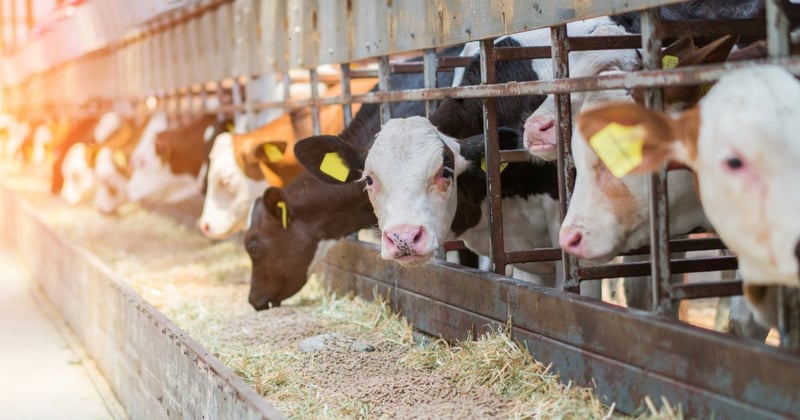
The more than 9 billion farmed animals raised in the US each year need to eat. As it turns out, producing their food comes at a heavy cost to the planet.
Producing enough food for the billions of farmed animals raised around the world is a tall order, and factory farms bring in large amounts of nutrients in the form of concentrated feeds and whole feed inputs. Getting this feed to farmed animals has devastating consequences for climate and habitat.
Roughly one-third of arable land is currently used for animal feed production and about one-third of all grain produced globally is fed to animals. More than 40% of wheat, rye, oats, and corn production is fed to animals, along with 250 million tons of soybeans and other oilseeds.
It is a terribly inefficient system, with more food, water, and land required to produce 1,000 calories of beef, for example, than 1,000 calories of grain.
Of the 339.5 million acres of land in the US in use for crop production, only 77.3 million acres (23%) of it is used to grow food for US consumers. 122.2 million acres (36%) is used for livestock feed, with the remaining land producing crops for export or corn for ethanol. It is estimated that livestock consume 70% of the grain grown in the US, and that half of the water consumed in the US is used to grow grain for cattle.
The use of land and fossil fuels to produce massive quantities of feed contributes significantly to global greenhouse gas emissions.
Feed crop production accounts for 17.2% of livestock’s emissions footprint globally. Although emissions from the animals themselves are often the focus of climate conversations, the Food and Agriculture Organization of the United Nations (FAO) points to six other channels associated with livestock production that contribute much more, including burning fossil fuels to produce mineral fertilizer used in feed production; land-use changes for feed production; and fossil fuel use during feed production.
In the US, 51% of chemical nitrogen fertilizer use is in the production of livestock feed, largely attributed to corn which covers large areas and demands high doses of nitrogen. FAO estimates that the US emits over 11 million metric tons of CO2 per year just from burning fossil fuels to produce nitrogen fertilizer for feed crops.
Despite its heavy costs to the environment, feed is extremely cheap for meat companies. The US government heavily subsidizes corn and soybeans through a variety of assistance programs paid for by taxpayers. The industrial farmed animal sector, as a large consumer of these crops, benefits greatly from the resulting cheap prices. A 2007 study found that the factory farm chicken industry alone saved $34.8 billion between 1997-2005 as a result of subsidy changes that significantly lowered the price of these feed inputs.
Thankfully, there is a better way forward. Recent research has highlighted a key strategy for improving the sustainability of livestock production: reduce the use of feed components that could otherwise be consumed by people (called “food-competing feed”). This requires a shift in the way we think of animals from viewing them as a source of protein to a part of a holistic system. By relying predominantly on grasslands and by-products from the human food supply, such as brans, whey, and oil cakes, the environmental pressures from farmed animal production can be greatly reduced. Cropland currently used for feed could grow human food or be left fallow to regenerate, and the shift in feed would lead to a corresponding reduction in animal production.
This food-not-feed strategy would contribute to the average human diet in 2050 consisting of 95% plants and 5% animal products (compared to current projections of 83% and 17%, respectively). The researchers also estimated that 90% fewer pigs and 85% fewer chickens would be farmed in 2050 compared to projected estimates should things remain the same. Greenhouse gas emissions, pesticide use, freshwater use, deforestation, and soil erosion would all be significantly reduced.
The extreme scale at which we are producing and consuming meat is quite simply inefficient and unsustainable—not to mention, cruel. The large amount of land and grain currently exploited to produce one calorie of protein from animals could serve a better purpose, whether growing food for humans or providing critical habitat to wildlife.
We can all take action every day to transform this system by increasing consumption of plant-based foods and decreasing the role of meat in our daily lives.